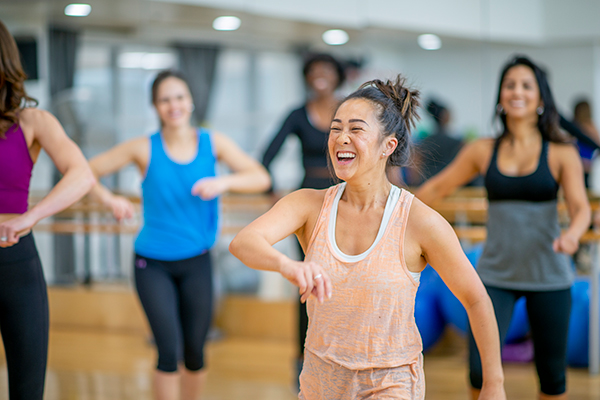Why You Pee When You Work Out (And How to Stop It)

I was sure everyone knew.
There I was, in the middle of a jump-rope set during a kickboxing workout when I felt a little (OK, a lot) of pee leak out. I freaked and high-tailed it to the bathroom — it was probably pretty obvious that I peed my pants.
“What do I do?” I thought. “Should I just leave? What if it happens again?”
I powered through, but spent the entire time worrying that everyone else in the class knew exactly why I bolted to the bathroom. I revealed the secret to my gym pal afterward and she laughed. “You too? It happens to me sometimes.”
That was both relieving and concerning.
If you occasionally pee when you workout you’re not alone. Stress incontinence is common, especially among women.
“Upwards of 15 percent of women are affected by stress incontinence,” says Kristin Rooney, M.D., a urogynecology specialist and assistant professor at the Baylor Scott & White Medical Center-Temple.
This is especially true for older women: A study published in 2015 by the University of California Davis showed that of the 3,000 women studied, 68 percent of the age 42 to 64 group experienced the effects of stress incontinence at least once a month.
But, do we have to live with it? No.
What Makes You Pee When You Work Out?
The leaking associated with stress incontinence results when the tendons and ligaments around the urethra stop supporting it sufficiently. Once it loses that support, the urethra isn’t as readily able to close off urine as it comes through the bladder, leading to the leaking.
As for what causes the urethra to lose its tone? There isn’t one main cause.
Instead, it can be brought about by a variety of factors, including pregnancy, vaginal childbirth, cesarean sections, and obesity. And once the urethra loses its tone, “anything that puts pressure on the pelvis and bladder can cause you to leak,” says Dr. Rooney.
That includes exercise. Jumping, running, and other moves that put a great deal of pressure on your bladder increase the likelihood that you’ll pee during a workout.
How to Fix Stress Incontinence
The good news is that you can strengthen your pelvic floor to help stop — or at least decrease — mid-workout leaking without medical intervention.

1. Kegels
“Your best place to start is with pelvic floor exercises — kegels,” says Dr. Rooney. “You can do them at home, anywhere.” The pelvic floor refers to the group of muscles that support the uterus, bladder, and rectum, forming a “hammock” of tissue.
One good way to activate the right muscles for kegel exercises is by pretending you’re trying to stop urine from coming out, as if you were in a long line for a bathroom. Simply mimic that contraction and hold for three seconds, then release. Repeat for 10 to 15 reps, then add more the next day.
That may sound simple, but many women don’t know how to do them the right way. “A lot of women will clench their butt or legs together instead of the proper muscles,” says Dr. Rooney.
In those cases, she opts to send patients to a physical therapist who can help them identify the right muscles, either through instruction or via pelvic floor stimulation.
“We’ll often do 50 to 100 repetitions in a short session,” she says, “as a slow introduction that’ll help them transition to doing them on their own.
2. Weight loss
And losing weight helps, too — it might even eliminate the problem altogether.
“Losing 20 to 30 pounds can make a significant difference in your stress incontinence,” says Dr. Rooney, noting that it can be a “catch-22” since “you work out to help lose weight, but working out makes you leak.”
3. Surgery
You should be able to eliminate — or at least reduce — your problem through simple measures without going under the knife. That said, some women do opt for surgery to fix the problem.
“Stress incontinence isn’t a life-threatening situation, but adding a mid-urethral sling or mesh around the urethra that brings it back into place can bring back the tone lost from other stressors,” Dr. Rooney Says.
She stresses that surgery is always your choice — you doctor might recommend it, but it’s not something you must do to alleviate the problem.
How to Manage Leaking During Your Workout

Maybe you’ve tried kegel exercises and they just aren’t your thing. Or, you don’t want to go the medical route to resolve the issue. That’s totally cool; you can still prevent pee when you work out — or at least mask the problem from others.
Inserts
If kegels don’t prove successful, there is a vaginal insert — called a high-impact pessary — that can work to provide support to the urethra during times of incontinence, like during a workout.
“These are temporary inserts,” says Dr. Rooney. “You put the pessary in when you need a little extra support and take it out when you’re done with your workout.”
Control water consumption
Sure, you want to stay hydrated, but all the liquid you have in your body has to go somewhere. A full bladder can make stress incontinence feel worse, leading to more chances for leakage. Instead, limit your water intake before and during your workout — and always go to the bathroom right before you start.
Tampons
Dr. Rooney says this is a trick she often shares with her patients. A thick tampon can act like a pessary and put enough pressure on the urethra to keep liquid from leaking out.
Any tampons will do, so experiment with different absorbencies until you find the one that gives you enough pressure. The brand Poise makes Impressa Bladder supports that look (and act) similar to tampons if you’d rather use those instead of your tampon stock.
Sanitary pads or panty liners
Pads and panty liners work to soak up any excess liquid that leaks out of your body, whether that be during your period or during a workout. Like tampons, the size — and absorbance level — differs among pads and panty liners, so experiment until you find one for you.
You can also opt for bladder control pads by brands like Poise. These are much larger than regular pads and cover a bigger area, ensuring nothing seeps onto your leggings.
Urine-wicking underwear
Bladder control underwear doesn’t have to feel like a diaper. Brands like Icon make pee-proof underwear designed to keep you odor-free and dry, thanks to its moisture-wicking material that can hold up to six tablespoons of liquid (!). Better yet: They come in a variety of cuts and colors, keeping you comfortable and coordinated during you workout. And confident, of course!
